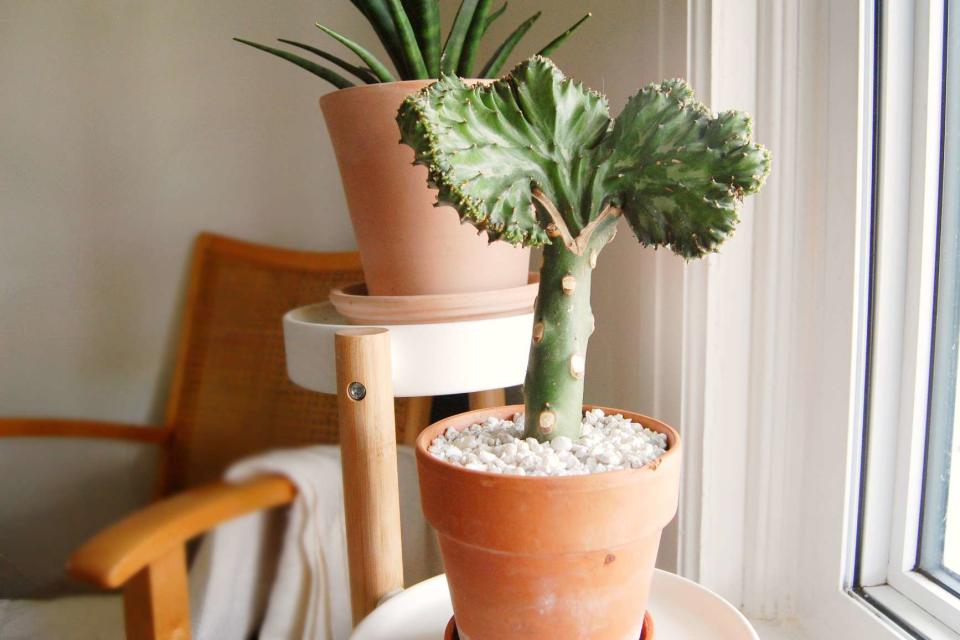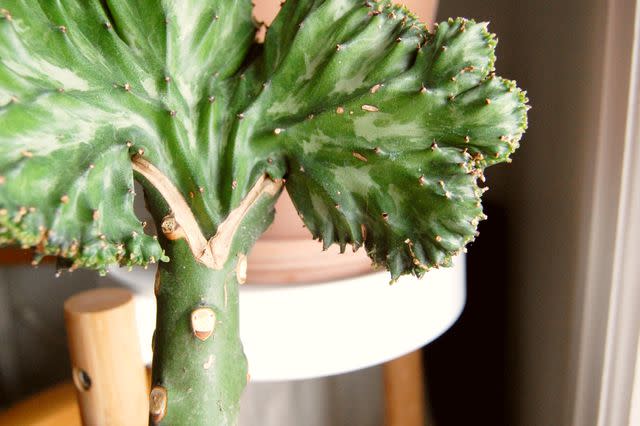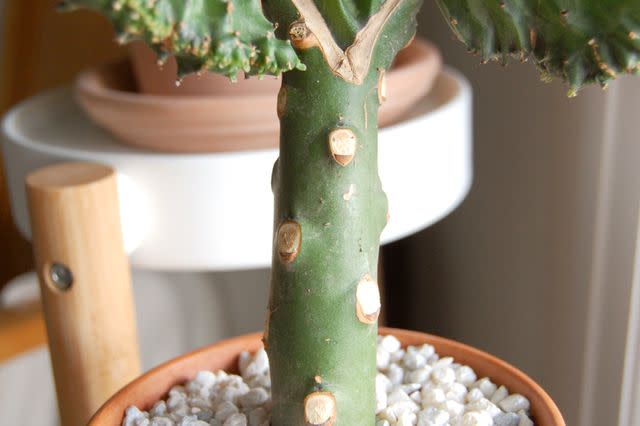How to Grow and Care for Coral Cactus
Two succulents grafted together make an other-worldly-looking plant

The Spruce / Cori Sears
Reviewed by Kathleen Miller
Despite its common name, the coral cactus isn’t a cactus at all. It is actually two different kinds of succulents that have been grafted together to create this sculptural, other-worldly-looking plant. The top ruffled portion of the plant is the crest of Euphorbia lactea, while the green ‘stem’ (or rootstock) is Euphorbia neriifolia. Once grafted together, these two Euphorbias make up the coral cactus. Depending on the variety of Euphorbia lactea used to create the coral cactus, the top crest of the plant ranges from green to blue-grey to whitish-green in color. The coral cactus is a popular houseplant, not only because of its unique appearance but also because it’s low-maintenance and easy to care for.
Like all plants in the Euphorbia genus, the latex sap of the coral cactus is toxic to humans and pets.
Common Name | Coral cactus, crested Euphorbia, crested elkhorn, crested candelabra plant, candelabra plant |
Botanical Name | Euphorbia lactea ‘Cristata’, Euphorbia lactea x neriifolia |
Family | Euphorbiaceae |
Plant Type | Succulent |
Mature Size | 1-2 ft. tall, 8-16 in. wide |
Sun Exposure | Full, partial |
Soil Type | Sandy, well-drained |
Soil pH | Acidic, neutral, alkaline |
Bloom Time | Spring, summer |
Flower Color | Pink, purple |
Hardiness Zones | 10-11 (USDA) |
Native Area | Cultivar, no native range |
Toxicity | Toxic to humans and pets |
Coral Cactus Care
Here are the main care requirements for growing a coral cactus:
Place the cactus in a location with at least four hours of direct sunlight per day or in partial shade when planting it outdoors.
Use light, well-draining soil or cactus and succulent soil when potting the plant.
Water regularly whenever the top 2 inches of soil feel dry.
Avoid exposing it to temperatures below 60 degrees F.
Fertilize monthly during the spring and summer.
Prune stems that are sprouting from the base.

The Spruce / Cori Sears

The Spruce / Cori Sears

The Spruce / Cori Sears
Light
This succulent does best with plenty of light. When growing the coral cactus indoors, choose a location with at least four hours of direct sunlight per day, ideally in an east-facing window so it gets afternoon shade. Make sure that you rotate your plant regularly (if you are growing it in containers) to prevent lopsided growth. If you choose to grow your coral cactus outdoors where the light is more intense, a partially shaded location is best.
Soil
Use a light, well-draining potting mix that is amended with plenty of perlite and sand. Cactus and succulent potting mix is designed specifically for these types of plants and provides lots of drainage. To make your own, mix together three parts potting soil, three parts coarse sand or gravel, and two parts perlite or pumice.
Water
The coral cactus is not as drought-tolerant as some of its close relatives in the Euphorbia family. It should not be allowed to dry out completely for more than a couple of days and does best when watered once the top 2 to 4 inches of soil are dry. In the spring and summer, you need to water the plant more often than in the fall and winter.
Temperature and Humidity
This plant needs warm, dry conditions which makes it well-suited as a houseplant or for outdoor growing year-round in USDA zones 10 to 11. In colder regions, the potted plant can be moved outdoors during the summer and brought back inside in the fall. Coral cactus cannot tolerate temperatures below 60 degrees F.
Fertilizer
Coral cactus is a slow grower that does not need a lot of fertilizer. However, it benefits from a fertilizer designed for cacti and succulents. Apply it monthly during the spring and summer and stop fertilizing in the fall.
Pruning
The only pruning coral cactus needs is to remove any dead or diseased plant parts. There might be extra stems growing from the base of the stem. To keep the plant in its original shape, remove them with a sharp pair of pruning shears or scissors.
Propagating
Because coral cactus was created by grafting two species, it can only be propagated by another graft, not from cuttings or seed. Not only does grafting require two healthy plants, Euphorbia neriifolia and Euphorbia lactea, but the grafting process is also finicky and involved. It is easier and just as economical for home gardeners to purchase a new plant.
Potting and Repotting Coral Cactus
Due to the fact that these plants are grafted, they rarely (if ever) outgrow their pots. However, it is still a good idea to repot them every few years to provide the plant with fresh soil and upsize the pot if needed. Wait until the spring or summer months when the plant is actively growing to repot, as this will prevent the plant from going into shock.
Common Pests & Plant Diseases
Watch out for common houseplant pests like scale, mealybugs, spider mites, and aphids. If you notice pests on your plant, isolate it from your other plants immediately and remove any visible pests with an alcohol-soaked cotton swab. Use neem oil or insecticides to help treat more serious infestations. In addition to these common pests, coral cacti are also susceptible to root rot which usually results from overwatered conditions.
Common Problems With Coral Cactus
Besides some common houseplant pests and diseases, caring for the coral cactus is relatively simple and problem-free. However, there are a couple common problems to watch out for, including yellowing, and brown spots developing on the rootstock or top crest of the plant.
Yellowing
If your coral cactus is turning yellow it is likely that the plant is suffering from overwatering. While these succulents enjoy more frequent watering than some other types of Euphorbias, they should still be allowed to dry slightly between waterings and should never be kept in consistently moist soil conditions. If you suspect overwatering is the culprit, repot your coral cactus with fresh, dry soil immediately.
Brown Spots
Brown spots may show up on your plant in two different ways—as brown mushy spots or as hardened ‘crispy-looking’ spots. Out of the two, brown mushy spots are by far the more concerning result and are usually an indication of some kind of rot or fungal infection. Check the roots of your plant in order to rule out root rot. If root rot is not the culprit, then it’s likely that your coral cactus is suffering from a fungal infection, at which point cutting out the affected area is the best course of action.
Usually, hard brown spots are less concerning and are sometimes just a ‘scar’ on the plant’s skin from a previous wound that healed over. They can also be a result of sunburn which might occur
if your plant is suddenly moved from a shady location to an extremely bright location.
Frequently Asked Questions
Why is my coral cactus growing stems and leaves?
It is not uncommon for an older coral cactus to start growing new stems and leaves from the bottom of the plant. This is a natural progression of the growth of the Euphorbia neriifolia which makes up the rootstock of the coral cactus. While it may change the overall look of your coral cactus, it is a sign that the plant is happy and growing well. If you don’t like the look of it, just prune them.
Why is my coral cactus turning pink?
Environmental stress can cause the top portion of a coral cactus to start turning pink. While it sounds bad, stress isn’t necessarily a bad thing for a plant although it is usually an indication that something in the plant’s growing environment has changed. For example, if you recently moved your coral cactus from a partially shaded location to a bright location you may notice its colors change. As long as the plant’s overall conditions are still okay your plant is likely going to be fine. Try to determine which change is causing the stress and reverse it.
When will my coral cactus bloom?
Coral cactus rarely blooms and when it does flower in the spring or summer, there is a good chance you will miss it. The buds that grow from the margins of the cabbage-like leaves are tiny and more noticeable flower clusters develop only in only older and larger coral cacti.
Read the original article on The Spruce.

